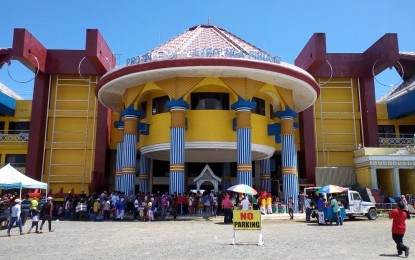
Zamboanga Sibugay Provincial Capitol Building
IPIL, Zamboanga Sibugay--The government’s war against illegal drugs is gaining headway in this province, an official said Monday.
Laurefel Gabales, Philippine Drug Enforcement Agency (PDEA) regional director, said this came about as 34 barangays have been declared as drug-cleared and drug-free communities in this province.
Zamboanga Sibugay, which comprises 16 municipalities, has a total of 390 barangays.
Gabales said the declaration is an indication of the success of the government’s war against illegal drugs here.
He said the drug-cleared and drug-free barangays are located in the towns of Olutanga, Imelda, Diplahan, Buug, Siay, Naga, Tungawan, Titay.
“We commend the Philippine National Police (PNP) and the local government units for doing their job to get rid their respective barangays of the menace of illegal drugs,” he said.
For a barangay to be declared drug-cleared and drug-free, according to Gabales, it must meet the following criteria: non-availability of the supply of illegal drugs; absence of drug den, pusher, and user; absence of clandestine laboratory of illegal drugs; active involvement of barangay officials in anti-illegal drugs activities; presence of drug awareness, preventive education, and information; and existence of compulsory and voluntary drug treatment and rehabilitation processing desk.
These requirements are mandated by Resolution No. 3 series of 2017 of the Dangerous Drugs Board (DDB).
The clearing of drug-affected barangays undergoes three phases: pre-operation, operation, and post-operation.
During the pre-operation phase, according to the regulation issued by DDB, the groundwork and bases of effective and sustainable operations against illegal drugs are laid down.
At this stage, house clusters are organized and a cluster leader for each barangay is designated.
The cluster leader is tasked to report to the chairman of the Barangay Anti-Drug Abuse Council (BADAC) all the necessary information such as the names of pushers and users, marijuana cultivation activities, clandestine laboratory operations, and other information related to illegal drugs.
Based on the information submitted by cluster leaders, the Municipal Anti-Drug Abuse Council (MDAC) in coordination with the police will formulate and validate the watch list of suspected drug personalities after which the operation phase will commence.
The operation phase is the actual implementation of strategies for the reduction of the supply and demand in the drug-affected barangays.
Lastly, the post-operation phase requires a commitment from the officials of the affected barangays to fund programs and activities to maintain the status of drug-cleared and drug-free barangay.
Gabales last week led the issuance of drug-cleared and drug-free certificates to the 34 barangays of this province.
The oversight committee is chaired by Gabales while the Regional Director of the Department of Interior and Local Government is the vice chair. Committee members include the representatives of the PNP, Department of Health, and local government unit appointed by the municipal mayor.
But Gabales explained that the declaration of a barangay as cleared and free of illegal drugs can be reversed to a drug-affected barangay if there are new reports of illegal drug activities.
The barangay will be asked by the oversight committee to take actions within 30 days to address the reported resumption of illegal drugs activities.
The failure of the BADAC to address the report would be a basis for the reversion of status from drug-cleared to drug-affected barangay.
Governor Wilter Yap Palma challenged the barangays to maintain their status as drug-cleared and drug-free.
“I am asking all the barangay leaders to be serious in the campaign to make our barangays in the province free from the menace of illegal drugs,” he said. (PNA)
